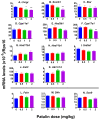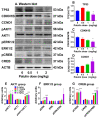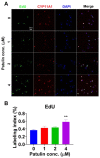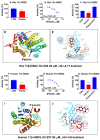Patulin Stimulates Progenitor Leydig Cell Proliferation but Delays Its Differentiation in Male Rats during Prepuberty
- PMID: 37756007
- PMCID: PMC10538017
- DOI: 10.3390/toxins15090581
Patulin Stimulates Progenitor Leydig Cell Proliferation but Delays Its Differentiation in Male Rats during Prepuberty
Abstract
Patulin is a mycotoxin with potential reproductive toxicity. We explored the impact of patulin on Leydig cell (LC) development in male rats. Male Sprague Dawley rats (21 days postpartum) were gavaged patulin at doses of 0.5, 1, and 2 mg/kg/day for 7 days. Patulin markedly lowered serum testosterone at ≥0.5 mg/kg and progesterone at 1 and 2 mg/kg, while increasing LH levels at 2 mg/kg. Patulin increased the CYP11A1+ (cholesterol side-chain cleavage, a progenitor LC biomarker) cell number and their proliferation at 1 and 2 mg/kg. Additionally, patulin downregulated Lhcgr (luteinizing hormone receptor), Scarb1 (high-density lipoprotein receptor), and Cyp17a1 (17α-hydroxylase/17,20-lyase) at 1 and 2 mg/kg. It increased the activation of pAKT1 (protein kinase B), pERK1/2 (extracellular signal-related kinases 1 and 2), pCREB (cyclic AMP response binding protein), and CCND1 (cyclin D1), associated with cell cycle regulation, in vivo. Patulin increased EdU incorporation into R2C LC and stimulated cell cycle progression in vitro. Furthermore, patulin showed a direct inhibitory effect on 11β-HSD2 (11β-hydroxysteroid dehydrogenase 2) activity, which eliminates the adverse effects of glucocorticoids. This study provides insights into the potential mechanisms via which patulin affects progenitor LC development in young male rats.
Keywords: cell cycle; mycotoxin; progesterone; steroidogenesis; testosterone.
Conflict of interest statement
The authors declare no conflict of interest.
Figures










Similar articles
-
Low dose of fire retardant, 2,2',4,4'-tetrabromodiphenyl ether (BDE47), stimulates the proliferation and differentiation of progenitor Leydig cells of male rats during prepuberty.Toxicol Lett. 2021 May 15;342:6-19. doi: 10.1016/j.toxlet.2021.02.006. Epub 2021 Feb 10. Toxicol Lett. 2021. PMID: 33581290
-
Bisphenol S stimulates Leydig cell proliferation but inhibits differentiation in pubertal male rats through multiple mechanisms.Environ Toxicol. 2023 Oct;38(10):2361-2376. doi: 10.1002/tox.23873. Epub 2023 Jun 26. Environ Toxicol. 2023. PMID: 37357847
-
Bisphenol A stimulates differentiation of rat stem Leydig cells in vivo and in vitro.Mol Cell Endocrinol. 2018 Oct 15;474:158-167. doi: 10.1016/j.mce.2018.03.003. Epub 2018 Mar 7. Mol Cell Endocrinol. 2018. PMID: 29524480
-
Dicyclohexyl phthalate blocks Leydig cell regeneration in adult rat testis.Toxicology. 2019 Jan 1;411:60-70. doi: 10.1016/j.tox.2018.10.020. Epub 2018 Nov 1. Toxicology. 2019. PMID: 30391266
-
Regulation of Leydig cell steroidogenic function during aging.Biol Reprod. 2000 Oct;63(4):977-81. doi: 10.1095/biolreprod63.4.977. Biol Reprod. 2000. PMID: 10993816 Review.
References
-
- Zhang T., Yan M., Hou X., Chang M., Song W., Yue T. Identification of mouse metabolic variations related to patulin-induced acute and subacute hepatotoxicity by ultra-high-performance liquid chromatography high-resolution mass spectrometry. Food Res. Int. 2023;166:112546. doi: 10.1016/j.foodres.2023.112546. - DOI - PubMed
Publication types
MeSH terms
Substances
LinkOut - more resources
Full Text Sources
Research Materials

